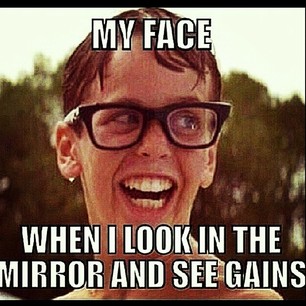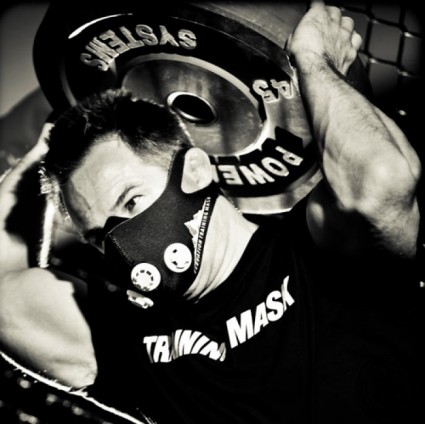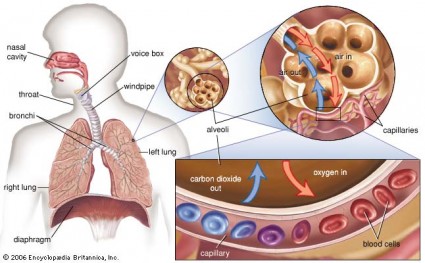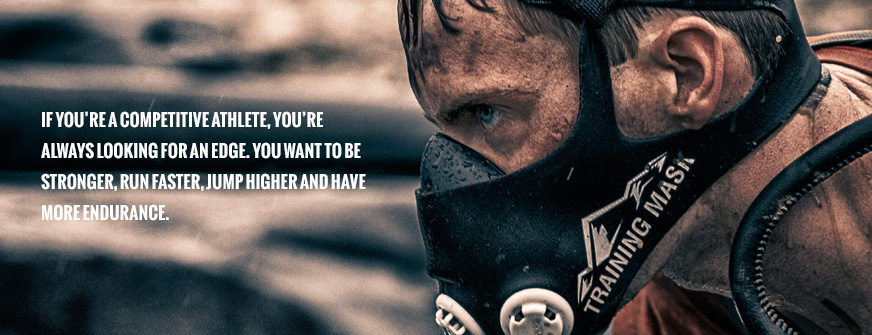The “Bane Mask” Training Mask 2.o
The makers of the mask claim training with it simulates training at a high altitude environment..
This is why dumbing things down is usually a bad idea:
“Train at altitude because there is less oxygen, you’ll get used to that and when you come back to sea level you’ll perform better”
Except that statement is false.
Truth: you may…maaaay
Perform better at sea level after training at altitude, but then again, maybe not.
In fact, most sports scientists believe the “Train lo- live high” approach to be best.
performance at altitude, acclimatization and/or hypoxic exercise is preferable; for performance at sea level, living at altitude (acclimatization) with sea level training may be the optimal strategy. However neither approach is a substitute for a carefully designed training program including appropriate rest and nutrition. – B. D. Levine, J. Stray-Gundersen
The point is training at altitude because there is “less oxygen” is false.
There is exactly the SAME AMOUNT of oxygen molecules per liter of air at sea level as there is at the top of Mt. Everest.
 photo credit: blmiers2 via photopin cc
photo credit: blmiers2 via photopin cc
Then how come people wear “oxygen” tanks to climb mountains if there is just as much oxygen dumbbass?
Cause the pressure is different…
The atmosphere is made up of approximately 21% oxygen, 78 percent nitrogen, with the remaining one percent consisting of a bunch of other gases. This ratio of gases remains the same throughout the atmosphere but the pressure of the combined gases decreases with altitude. It is a change in pressure not a decrease in oxygen percentage that affects people at high altitude. Flying Magazine may 2006
How this whole lungs/ breathing thing works:
You breath in.
You’re diagram expands (hopefully) helping to suck air in, which is composed of not just oxygen, but nitrogen, carbon dioxide, car exhaust (whatever the hell that is made out of ) and even old crusty farts. <——yes, I made a fart joke, yes I’m 12 years old.
As the air is in your lungs a certain percentage gets pressed against the lining of your lungs, the aveoli.
Aveoli: Little bitty sacks that sit at the end of the branches of the lungs. <—–this is where oxygen transfer takes place.
The air presses up against the aveoli membranes on one side while blood (red blood cells) press up against aveoli on the other side.
When oxygen presses up against aveoli a red blood cell (with an open spot on the hemoglobin) presses up against the aveoli and the oxygen is transferred into the red blood cell and can be carried away to tissues.
from http://www.britannica.com/
So Why Does the Pressure Matter?
If the oxygen isn’t pressed up against the alveoli walls….it can’t pass through the membrane, therefore it can’t get taken up.
Some of the air in the lungs does not participate in gas exchange. Such air is located in the anatomical dead space within bronchi and bronchioles—that is, outside the alveoli.-Cliff Notes/sciences/anatomy-and-physiology/the-respiratory-system/lung-volumes-and-capacities
ALL THAT MATTERS IS WHAT MAKES IT ACROSS THE ALVEOLI MEMBRANE.
Not how much you breathe in. <—–I’m taking for granted here that you have normal lung functioning
So Why Do People Train in the Mountains?
The body doesn’t like to have homeostasis disrupted.
It likes to be in a physiological “balance” with its environment, IE chronic applied stressors.
So it adapts..
How would your body adapt to having less oxygen in the blood stream?
Can it:
A: Change the pressure of the atmosphere. I.E. the lung side of the tissues?
Or
B: Change the pressure/ volume/ chances for oxygen to transfer across the alveoli membrane on the blood side?
If you answered A, you’re probably either a Scientologist or one of these “The Secret” jack-offs who believes you can “think” things possible. <——you can’t, but you can work for things….I know, work sucks.
If you answered B. you might be, but you’re probably not a moron.
What Had Happened Was:
When the pressure in the lungs is decreased, chronically, the body responds to the decrease in oxygen transfer by creating more redblood cells to increase the transfer across the alveoli membrane<—-that’s why blood doping/ EPO works, more redblood cells to carry oxygen…and no, EPO is not a steroid.
More red blood cells means:
- More pressure is exerted against the aveoli wall forcing a higher rate of transfer.
- More redblood cells are present at transfer sites to pick up the oxygen that does make it across.
Why Training at Altitude May Have a Benefit:
Living at altitude probably is MUCH more advantageous, but for sake of argument…..
If you have more redblood cells in your blood you can transfer a higher volume of oxygen at sea level where the pressure forces more oxygen against the alveoli walls and across the membrane than it would at a higher altitude.
More Pressure and More Sites to Accept Oxygen
Win-Win
Except for the increased blood viscosity and the chance for heart attacks….granted this really isn’t a concern unless you are blood doping.
Just wanted to scare ya, and say something outrageous to gain attention. Too bad I put it in the middle of a two thousand plus word blog post.
But Is it Really A Win-Win?
Training at altitude gets a lot of hype but like most things, it seems the hype is a bit undeserved and effective altitude training is mostly misunderstood.
As with other forms of training-and all manner of medicine altitude training is most effective if tailored to each athlete’s unique physiology Sports Gene Pg 214
So You’re Telling Me Random Training Leads to Random Results?????
Yes…
Simulated hypoxia does not further improve aerobic capacity during sprint interval training.
Hypoxic and normoxic SIT caused improvement in V̇O2peak and TTE compared to a control. Hypoxic SIT did not cause further improvements, indicating hypoxia based SIT offers no additional benefit for improvement of endurance performance.- Richardson AJ1, Gibson OR.
Advancing hypoxic training in team sports: from intermittent hypoxic training to repeated sprint training in hypoxia
we report 23 controlled studies (ie, 20 IHT and 3 RSH) including training protocols performed in hypoxia versus normoxia. Interestingly, an additional benefit on performance-related variables of IHT compared with the same training performed in normoxia is present in only four of those studies.
A thorough analysis of studies that have used IHT leads to strikingly poor benefits for sea-level performance improvement, compared to the same training protocol performed in normoxia.
Despite the positive molecular adaptations observed after various IHT modalities, the characteristics of optimal training stimulus in hypoxia are still unclear and their functional translation in terms of whole-body performance enhancement is minimal.- Raphaël Faiss1, Olivier Girard2, Grégoire P Millet1
Intermittent normobaric hypoxia does not alter performance or erythropoietic markers in highly trained distance runners
In conclusion, a 4-wk regimen (5:5-min hypoxia-to-normoxia ratio for 70 min, 5 times/wk for 4 wk) of intermittent normobaric hypoxia is not sufficient to alter 3,000TT performance, V̇O2max, or indexes of accelerated erythropoiesis in highly trained distance runners. – , , , , , , , ,
Granted, it could be that the subjects, duration or training methodology of any of these studies is flawed less than perfect.
But no real improvement at sea level performance seems to be pretty constant.
Then again, and perhaps more likely the studies didn’t account for individual genetic variation and response to training:
Even with individual variation in altitude response there seems to be a rough “sweet spot” for training, an altitude where red blood cell production increases but not too much. Where the air is thin but not too thin….Anecdotally, the sweet spot is around six to nine thousand feet, high enough to cause physiological changes, but not so high that the air is too thin for hard training. – Sports Gene Pg 214
The Air is Too “Thin” For Hard Training, Until You’ve Been There A While, Finally Getting to My Point:
Just because it’s harder doesn’t mean it’s better.
Ever try to run with only a straw to breath through?
Why not?
It’s harder….
Stupid,
But harder.
Enter the Bane Mask Elevation Training Mask…2.0
These hypoxia masks claim to create a training at altitude or hypoxic environment, that means less oxygen is available in the blood stream than is needed by the tissues.
How does this happen?
Evidently breathing through the mask restricts the flow of oxygen, or at least air.
Less air + Exercise = Tissue Hypoxia = red blood cell increase.
So the point of the mask is to ultimately restrict the volume of air that enters the lungs.
Here’s the thing:
Limiting how hard you can work means your intensity and duration (at that intensity) is limited.
Since at altitude the transfer of O2 to the active muscles is reduced, particularly during whole body exercise, fatigue occurs at lower work rates– Effects of High Altitude on Sleep and respiratory Systems and Their adaptation
Therefore, so are your gainzzzzz….

You’ll enter into an anaerobic environment (remember you don’t have adequate O2) at a lesser work rate which destroys cellular mitochondria..
You know, the things that produce energy in the cells.
Therefore you don’t get ANY of the adaptations that you’d get with training at altitude and you may be detraining.
Life is good and the Living’s EZ…
This is why living at altitude is of benefit…
Living is easy.
Going to the grocery store, washing the car, sitting in front of the TV, none of these take much effort, you’re always in a primarily aerobic state.
CHRONICALLY
You’re body can easily build those redblood cells and adapt to the new “thinner air” environment.
This is why Live High Train Low is popular now.
Train as hard as you can <—-at sea level
Live in an environment that facilitates the increase of redblood cells <—-at altitude
But Don’t Throw the Bane Mask Away Yet, Halloween is Almost Here:
These things might have a purpose and surprisingly it’s the purpose that they actually state on their website, NOT the assumed purpose everyone thinks the mask is for. <—-in fairness, they do call it an “Elevation Training Mask”, so they lied…..
Elevation Training Mask is a patented (PAT.8.590.533 B2) “Resistance Training Device” that helps condition the lungs by creating pulmonary resistance and strengthening the diaphragm.”- Training mask 2.o
There may be some performance improvements with restricted breathing in the strength and endurance of the diagram and intercostals.
But does this type of training matter?
Does it actually lead to a physiological difference that transfers to performance?
Maybe, maybe not:
We concluded that although swim training results in attenuation of the ventilatory response to hypercapnia and in improvements in pulmonary function and sustainable breathing power, supplemental respiratory muscle training has no additional effect except on dynamic pulmonary function variables. Effects of concurrent inspiratory and expiratory muscle training on respiratory and exercise performance in competitive swimmersGregory D. Wells,Michael Plyley,Scott Thomas,Len Goodman,James Duffin
Heart rate, ventilation, or venous blood lactate, at equal work-rates during the incremental exercise test or at equal times during the fixed work-rate endurance test were not changed significantly across these exercise trials in either group. We propose that the effect of RMT on exercise performance in highly trained cyclists does not exceed that in a placebo group. Effects of respiratory muscle training versus placebo on endurance exercise performance –David A. Sonetti, Thomas J. Wetter, David F. Pegelow, Jerome A. Dempsey
It may be concluded that 10 wk of SIMT can increase the inspiratory muscle performance in well-trained athletes. However, this increase was not associated with improvement in aerobic capacity, as determined by VO2max, or in arterial O2 desaturation during maximal graded exercise challenge. Specific inspiratory muscle training in well-trained endurance athletes. Inbar O, Weiner P, Azgad Y, Rotstein A, Weinstein Y
So it does look like the respiratory (especially inspiratory/ inhalation) muscles get stronger, but it doesn’t seem to make a difference..
At least not when the person is in shape.
Remember, Lung Capacity is pretty much set in stone and we don’t even use most of the oxygen we breath in so once you’ve reached maximal saturation…
That’s it.
A stronger, deeper, breath won’t matter….only the ability to USE the oxygen will and you’re NOT adding aveoli surface area.
What about people who are in terrible to just ok shape, will the Bane Mask 2.0 allow them to have super strength and break Batman’s back?
Yeah, I went old school
I Have NO Clue..
Why?
You just don’t do these types of studies on people in poor condition unless they have a disease state and then it’s really not fair to compare the data.
Because:
- When you really suck, anything works.
- Disease states mean your sh@t is broke, something is wrong, the outcomes are based on a different level of basic functionality.
Here’s what I think:
They would work, because anything does when you suck.
But as your respiratory muscles become stronger and your body has made other adaptions to your training ie, your diagram contracts and relaxes as it should, your redblood cells are plentiful, you’ve built a plentiful dense network of secondary capillaries, your Krebs cycle enzymes are plentiful etc, etc.
So it’s not really the mask, just the process of getting into shape.
The Training Mask 2.0 probably doesn’t do Jack Sh@t except make you feel miserable and slow you down.
But that might be a good thing for some folks.
See, I get some people who ONLY use the gym when they come see me (and that’s totally cool)
While I have others, primarily distance coaching clients <—-interested? click the link, you know you want to, who would train 10 times a week if I let them.
While I generally don’t prescribe “cardio”, I leave it up to the client to find something they can do without stabbing their eyes out in boredom tolerate.
Some people want or need strict structure and I have to write-up “cardio” for them.
This is so they do it or don’t sabotage their gainzzzz Bro by running half marathons or doing endless HIIT sessions….
And by “cardio” I mean “Cardiac Development Work”.
This sh@t aint, “go for a bike ride on Saturday with the kids”.
You’re gonna need a heart monitor and some discipline.
Here’s where the Bane Mask 2.0 might have some value:
The Mask will prevent you from breathing easily, effectively slowing you down and reducing the stress on the body.- Andrew Read
It’s similar to when I have people go yogging running while breathing only through the nose for recovery purposes.
It’s essentially self-limiting, you can’t go fast, so don’t try, just settle in at a nice pace, engage the aerobic system without stressing the body and facilitate recovery.
Again, you’d have to monitor the heart rate, but your work rate would be lower and, in my estimation, the total stress on the body at a given heart rate.
That alone could be a boon for athletes who have difficulty tolerating/ recovering from the pounding of aerobic work. <–especially older/ beat up athletes.
Why yog (it’s Swedish) when you can walk?
So go ahead and get the Bane Mask….Halloween only comes once a year.
Is that not Paleo…????
And you still wont look like Tom Hardy in it, your traps need some work Bro.
 from https://scifijubilee.wordpress.com
from https://scifijubilee.wordpress.com






